VIEWPOINTS ON THE ORIGIN OF BASQUE DIALECTS
The opinion that Basque dialects have an ancient origin has a long pedigree. Three scholars played a major role in the development of this idea: a) Oihenart, b) Larramendi, c) Caro Baroja.
Arnaut Oihenart (1592-1667)
Oihenart, in his book Notitia utriusque Vasconiae (1656), was the first scholar to pay attention to dialectal diversity in Basque. He distinguished four dialects and related them to ancient tribes from pre-Roman times: a) The dialect of the Aquitanians, spoken in the Northern Basque Country, b) the dialect of the Vascones, spoken in Navarre, c) the dialect of the Bardulians, spoken in Gipuzkoa and Araba, and d) the dialect of the Autrigones, spoken in Bizkaia. According to this viewpoint, these dialects are very old, of pre-Roman origin, continuing an ancient division of the Basque Country in tribes or lineages.
Manuel Larramendi (1690-1766)
Larramendi’s viewpoint on the origin of Basque dialects was not based on cold facts, but on heated arguments. He wanted to demonstrate that, in ancient times, Basque was the only language spoken throughout Spain. His opponents, though, pointed out that this is contradicted by the statements of Greek and Roman geographers and historians. The testimony of Greco-Roman writers clearly indicates there were many nations and languages in the Iberian Peninsula when the Romans arrived to its shores. In order to overcome this obstacle, Larramendi claimed that the languages of Spain mentioned by classical authors were not real “languages,” but dialects of Basque, and that this misconception occurred because the dialects of the Basque language were very different from each other. Furthermore, he made the claim, in the foreword of his Diccionario trilingüe (1745), that God himself created Basque and its dialects at the Tower of Babel.
Julio Caro Baroja (1914-1995)
Like Oihenart, Caro Baroja defended that the boundaries of the modern Basque dialects and the ancient tribes mentioned by Greco-Roman coincided. These ancient dialectal boundaries were allowed to persist after the tribal structure of the country disappeared because, in his view, the same boundaries were used by the Catholic Church in establishing its dioceses. He presented this viewpoint in two well-known books: Los pueblos del norte de la Península Ibérica (1943) [The Peoples of the North of the Iberian Peninsula] and Materiales para una historia de la lengua vasca en su relación con la latina (1945) [Materials for a History of the Basque Language in its Relation with Latin]. Due to the impact these books had, this viewpoint was widely accepted among scholars and the general public.
THE FOUNDATIONS OF THIS OPINION
The strongest and almost only evidence for the viewpoint that identifies the geographical boundaries of Basque dialects with those of ancient tribes and with medieval Christian dioceses is found in the western area. It is a fact that the speech of Alava/Araba, Bizkaia and the Deba Valley of Gipuzkoa is very similar. This whole area constituted the diocese of Alava/Araba, until the end of the 11th century, when it was merged with the diocese of Calahorra. Apart from that, it is believed that this entire area belonged to the Caristii in pre-Roman times—not to the Autrigones, like Oihenart had said. We thus see that the limits of Basque dialects, ancient tribes, and Christian dioceses coincide in the west.
The supporters of this viewpoint have often also mentioned the northeastern part of Gipuzkoa as providing further evidence; mainly the area of Oiartzun, Hondarribia and Irun. Bonaparte claimed that Navarrese Basque was spoken there. In Roman times this area belonged to the Vascones, whereas most of Gipuzkoa belonged to the Bardulians instead. This would also lend support to the hypothesis of continuity of dialect boundaries from antiquity. Nevertheless, there is a partial contradiction here: in the Middle Ages this area did not belong to the diocese of Iruñea, but to the diocese of Baiona.
Regarding language, there is in fact only one aspect of dialectal variation for which dialects, tribes, and dioceses coincide: the root vowel of the verb *edun ‘to have’. The root of this verb in the old Caristian area is -o- (dot ‘I have’), in the Bardulian zone it is -e- (det), and in the territory of the Vascones it is -u- (dut). Nonetheless, even for this feature, the coincidence is not complete, as -o- is not the only variant found in Caristian territory. Landucci’s dictionary (1562) appears to reflect the speech of Vitoria/Gasteiz, and the forms of *edun that it includes have the root vowel -u-: dut, duk, duzu. Even farther west than Vitoria/Gasteiz, in the Zigoitia region, R. M. Azkue recorded forms of edun with the root vowel -u- at the beginning of the 20th century.
KOLDO MITXELENA’S PERSPECTIVE (1915-1987)
In Mitxelena’s 1981 article “Lengua común y dialectos vascos,” he briefly addressed the issue of the origin of Basque dialectal diversity. In his opinion, dialectal fragmentation from a common form of language started in the Middle Ages, after the fall of the Roman Empire. His arguments were the following: a) All Basque dialects are rather similar to each other, and this lack of differentiation would not obtain had the Basque dialects been ancient, b) Latin loanwords have been adapted in a distinctive way in Basque, yet this adaptation has been the same across all dialects of the language. This could not have been possible if the Basque language had already been fragmented in different dialects by the time of the Roman conquest. If Basque had been divided in dialects, Latin loanwords would have been adapted following different phonological rules in each dialect, and this is not the case. For example, words like aingeru ‘angel’ (from Latin angelum), bake ‘peace’ (< Lat. pacem), borondate ‘will’ (< Lat. voluntatem), gela ‘room’ (< Lat. cella), etc. show the same types of phonological adaptations in all dialects.
Mitxelena’s viewpoint appears to be correct. We may add that the dialects that are most different from the rest are those spoken at the eastern and western ends of the Basque Country; that is, the Zuberoan and Western dialects. The differences in the rest of the Basque-speaking territory are minimal. The Basque varieties of Lapurdi, Low Navarre, Navarre and Gipuzkoa are all very similar. Of course, this would not be the case if the dialects of Basque were truly ancient.
THE UNITY OF BASQUE DIALECTS
Whenever Basques from different places have gathered, they have often resorted to foreign languages in order to communicate more easily. There is evidence that this has been a common practice for centuries. This can be attributed to the fact that until very recently Basque has lacked a standard variety. The differences among dialects are, in fact, rather small. More precisely, it is the dialects spoken at the two ends of the Basque Country that are most different: The Zuberoan or Souletin dialect and the Western dialect. The speech of the valleys of Erronkari (Roncal) and Zaraitzu (Salazar) was also unique. Apart from that, nowadays most problems for mutual comprehension are due to the political border that separates the Basque Country in two. After all, the Basque speech of one side of the border feeds off Spanish whereas the other feeds off French. Let us consider the main differences and similarities among dialects in phonology, morphology, syntax and lexicon:
Phonology
The inventory of vowels and consonants and phonotactic rules are almost the same in all dialects.
The only difference in vowel inventory is the use of the vowel ü in Zuberoan, which may reflect influence from Occitan. In addition, there are nasal vowels in Zuberoan (in the process of being dephonologized nowadays). It should be added that there is evidence of nasal vowels also in the west, in Bizkaia and the Deba Valley in the 16th and 17th centuries. Therefore, it seems that nasal vowels were once common to all Basque dialects.
With respect to consonants, the existence of aspiration in some varieties is the most conspicuous difference. Nowadays, aspiration is still alive in some areas of the Northern Basque Country, mainly in Zuberoa. Again, there is evidence that the phoneme /h/ was once found throughout the Basque Country. Medieval documentation shows the abundant use of this phoneme in the toponymy of Araba/Alava, in the southwestern corner of the Basque Country.
Concerning sibilants, there are differences from place to place as well, but looking closely at older documents, we can see that this is a recent innovation: In the Western dialect and some areas in the north of Gipuzkoa, the contrast between the two fricatives s (voiceless apico-alveolar), z (voiceless lamino-dental) has been lost, as well as that between the two corresponding affricates ts and tz. On the other hand, the number of sibilants has increased in Zuberoa, with the addition of voiced phonemes, apparently due to Occitan influence.
Another difference in consonants concerns the evolution of word-initial *j-. This sound is pronounced in many different ways across the Basque Country, but it seems to be that all pronunciations come from the same development: y (yan) > dx (dxan) > x (xan) > j (jan) (IPA [j] > [ʒ] > [ʃ] > [χ]). Some pronunciations have gone further than others in this development.
To close this section, the most striking variation across dialects is found in the prosodic domain; that is, word-stress and intonation (see Hualde 1997).
Noun Morphology
Compared to its neighboring languages, a noticeable feature of Basque is its postpositional system, which is similar across all dialects. Regarding dialectal differences, we must note the distinctive means to indicate the directional allative case (‘towards’) in the Northern Basque Country and in the Western area. In the Northern Basque Country, the construction -ri/-rat buruz is used: Pariserat buruz joan da ‘s/he has gone towards Paris’; udaberriari buruz egunak luzeagoak dira ‘towards Spring, days are longer’. In the Western dialect, the suffix -rantza/-rutz is used, instead: Pariserantza/Pariserutz joan da ‘s/he has gone towards Paris’.
There are also dialectal differences regarding four other morphological cases:
- 1. In Bizkaia, -gaz is used in the comitative case (‘with’): lagunagaz ‘with the friend’ in the singular, lagunakaz ‘with the friends’ in the plural.
- 2. In the benefactive case (‘for’), -entzat or -endako are used depending on the dialect: lagunarentzat/lagunarendako ‘for the friend’.
- 3. In the prolative case (‘as’), -tzat or -tako can be used: Pello laguntzat/laguntako daukagu ‘we have Pello as a friend, we consider Pello our friend’.
- 4. There are two options to form the animated inessive case (‘in, on’): -gan and baitan following the genitive suffix, as in lagunarengan/lagunaren baitan badut konfiantza ‘I have confidence in my friend’.
In addition to these five differences, there are a few others, some of a phonetic nature. In the ergative plural, -ak is used in Western and Central dialect areas and -ek is used in the east: gizonak/gizonek egin dute ‘the men have done it’. In the dative plural, we find -ei/-eri/-er: lagunei/laguneri/laguner eman diet ‘I have given it to my friends’. In the genitive singular, we find the forms -aren/-aen/-ain/-an: lagunaren/lagünaen/lagunain/lagunan etxean egon naiz ‘I have been in my friend’s house’. In the comitative, we find -kin/-ki/-kilan: lagunarekin/lagunareki/lagunarekilan ibili da ‘s/he has been with his/her friend’. In the ablative case, -tik/-ti/-tikan/-tio are used depending on the area: etxetik/etxeti/etxetikan/etxetio atera da ‘s/he has gone out of the house’. In the motivative case, we find the variants -gatik/-gati/-gatikan/-gatio: zu ikusteagatik/ikusteagati/ikusteagatikan/ikusteagatio etorri naiz ‘I have come to see you’.
There is also some variation in the choice of grammatical case in specific contexts. For instance, the subject of an uninflected verb in a subordinate clause takes the genitive case in the east and the absolutive case in western and central regions: laguna/lagunaren ikustera joan da ‘s/he has gone to see his/her friend’. Nominalized verbs may also take different cases as complements of specific verbs depending on the dialect. For instance, jaten/jatera eman ‘to give (something) to eat’, joaten/joatera utzi ‘to let go’, egiten/egitera ausartu ‘to dare do’, etc.
Finally, we find variation in the form of strengthened pronouns. For instance, the strengthened form of nik ‘I, ergative’ is neuk, neronek or nihaurk depending on the dialect.
Verb Morphology
In this section, we will consider the most significant aspects of variation in verb morphology.
To begin with, in a number of instances, auxiliary verbs are formed on different roots depending on the dialect. For example, the forms of the trivalent indicative auxiliary may be based on one of three distinct verb roots: *i (diot ‘I have it to him/her’), *eradun (deraukot > dakot, same meaning) and eutsi (deutsat > dotset, same meaning). In the potential mood of the transitive auxiliary, there are three choices as well: *ezan (dezake ‘s/he can’), egin (daike, same meaning) and *iro (diro, same meaning).
Future tense morphemes divide the Basque Country in two. In the west and center of the Basque Country, -go is used with participles ending in -n: izango ‘will be’, egingo ‘will do’. In the east, -en is used: izanen, eginen. The geographical distribution is similar for the use of the verb root vs the perfective participle in non-indicative forms. In the Western and Central dialects, as well as in an area of Navarre, the participle is used: kendu zaitez ‘get out’. In the east, the verbal root is used instead: ken zaitez.
There is a wide array of options to mark plurality of an absolutive argument in conjugated verbs and auxiliaries: -tza-, -zki-, -it-, -zi, -z… For instance: goaz/goazi ‘we go’, dizkio/deutsaz/ditio ‘s/he has them to him/her’, daramatzat/daramazkit ‘I carry them’, etc.
There are other aspects of variation as well. The first person singular of the present tense of *edun ‘to have’ can be dut/det/dot ‘I have it’; the first person singular of the present tense of izan can be naiz/niz/naz ‘I am’; and the first person plural can be gara/gera/gira ‘we are’. Finally, in the 3rd person singular of the verb izan bearing a subordinating suffix, we have the options -a-/-e-: dan ‘that it is’, dala ‘that it is’, zan ‘that it was’, zala ‘that it was’ in the west and center, and den, dela, zen, zela in the east.
Syntax
There is little dialectal variation in syntax. Three aspects can, nevertheless, be highlighted. In the Northern Basque Country, the verbal prefix ba- is used in contexts where it would not be used in the south: gizon batek bi seme bazituen ‘a man had two sons’, vs gizon batek bi seme zeuzkan. Also in the Northern Basque Country, the auxiliary is placed before the participle when there is focus: nor duzu ikusi? ‘who have you seen?’ (vs nor ikusi duzu?). Finally, in the Southern Basque Country, egin is used to emphasize or focalize the verb: Mikelek erre du ‘Mike smoked’(neutral clause) vs Mikelek erre egin du ‘what Mikel did was to smoke’ (emphasized verb).
Lexicon
In most languages, the lexicon is the area that shows the greatest amount of dialectal variation, and this is also the case in Basque. The degree of uniformity that we find in this area, however, is greater than expected. For example, verbs expressing basic actions are usually the same in all dialects: egon ‘to be, stay’, izan ‘to be’, edan ‘to drink’, jan ‘to eat’, saldu ‘to sell’, sartu ‘to get in, enter’, ekarri ‘to bring’, kendu ‘to take away’, etc. Most adjectives are also the same in all dialects: handi ‘big’, txiki/ttipi ‘small’, zabal ‘wide’, mehe ‘thin’, arin ‘fast’, zorrotz ‘sharp’. The words for numbers are also the same everywhere: bat ‘one’, bi ‘two’, hiru ‘three’, hamar ‘ten’, hogei ‘twenty’, ehun ‘a hundred’. More generally, all basic words of the language are usually the same in all dialects. Here some examples:
- Color names: beltz ‘black’, gorri ‘red’, urdin ‘blue, gray’, zuri ‘white’…
- Body parts: aho ‘mouth’, begi ‘eye’, belaun ‘knee’, buru ‘head’, oin ‘foot’…
- Family relationships: alaba ‘daughter’, ahizpa ‘sister of a woman’, anaia ‘brother’, arreba ‘sister of a man’, senar ‘husband’…
- Human beings: andre ‘woman, lady’, gizon ‘man’, neska ‘girl’, ume ‘child’…
- Feelings: amets ‘dream’, esker ‘thanks’, gogo ‘desire; memory’, lotsa ‘shame; fear’…
- Names of places of residence: etxe ‘house’, herri ‘village, country’, hiri ‘town’…
- Parts of the house and household items: ezkaratz ‘entrance hall’, labe ‘oven’, leiho ‘window’, su ‘fire’…
- Tools: aitzur ‘hoe’, hede ‘strap’, igitai ‘sickle’, orratz ‘needle’…
- Space: ezker ‘left’, ipar ‘north’…
- Time: atzo ‘yesterday’, lehen ‘first’…
- Quantity: erdi ‘half’, oso ‘whole’…
- Names of mammals, birds and insects: behor ‘mare’, idi ‘ox’, txakur ‘dog’, arrano ‘eagle’, eper ‘partridge’, erle ‘bee’, zorri ‘louse’…
- Names of trees and flora: haltz ‘alder’, haritz ‘oak’, belar ‘grass’…
- Names of minerals and earthly elements: burdina ‘iron’, harri ‘rock’, ikatz ‘coal’, urre ‘gold’, zilar ‘silver’…
- Food and drinks: aza ‘cabbage’, esne ‘milk’, gatz ‘salt’, gazta/gazna ‘cheese’, haragi ‘meat’, ogi ‘bread’…
- Weather phenomena: ekaitz ‘storm’, elur ‘snow’, euri ‘rain’, haize ‘wind’…
- Geographic designations: itsaso ‘sea’, larre ‘prairie’, leize ‘cave’, lur ‘land’, mendi ‘mountain’…
COMMON INNOVATIONS IN ALL DIALECTS
Koldo Mitxelena, in his article “Lengua común y dialectos vascos” (1981), provided a very strong argument for the position that Basque dialects are not very old; namely, that the same innovations are found in all dialects. Moreover, some of these innovations are relatively recent. This, of course, would not be the case if Basque dialectal diversification had started a long time ago.
Many Latin loanwords are examples of this. Many of these words have been adapted to Basque in a very distinctive way, and these adaptations have been the same in all dialects. Here is an example: the Latin word pace(m) became bake in Basque. This adaptation, with voicing of the initial consonant and maintenance of the intervocalic /k/, is very different from the way this word has evolved in the neighboring Romance languages, yet this word is pronounced as such in all dialects (except that in a central area the word is pake).
These are the main rules concerning the adaptation of Latin words into Basque:
- 1. Muta cum liquida consonant clusters like p, t, k, b, d, g, f + l, r have been eliminated, following one of two routes. The two options for adaptation are the following: a) The first consonants is dropped (Lat. pluma > Bq. luma ‘feather’), or b) an anaptyctic vowel is inserted between the two consonants (Lat. cruce > Bq. gurutze ‘cross’).
- 2. Word-initial trills are not allowed; the vowel a- or e- is epenthesized before them. We find words like errege ‘king’, Erroma ‘Rome’, erromeria ‘religious festival’, errota ‘mill’, arrazoi(n) ‘reason’, etc., in all dialects.
- 3. Word-initial p-, t-, k- turn into b-, d-, g- in Basque: Lat. tempora > Bq. denbora ‘time’, Lat. causa > Bq. gauza ‘thing’, Lat. cella > Bq. gela ‘room’.
- 4. There have been four developments intervocalically. Firstly, -n- is dropped (Lat. corona > Bq. koroa ‘crown’). Secondly, l becomes r (Lat. angelu > Bq. aingeru ‘angel’). Thirdly, -nn- becomes -n- (Lat. annona > Bq. anoa ‘portion’). Fourthly, -ll- becomes -l- (Lat. castellu > Bq. gaztelu ‘castle’).
There is one more thing worth noticing regarding Latin loanwords: a great number of words coming from Latin have spread to all dialects; for instance, eremu ‘lot, piece of land’, joko ‘game’, landare ‘plant’, soka ‘rope’, etc., are found throughout the Basque Country.
Compound words are not very ancient either and their formation rules are the same in all dialects. These are the main rules:
- 1. The syllables -di/-gi at the end of the first member of the compound become -t: ardi + zain > artzain ‘shepherd’, begi + ile > betile ‘eye-lash’.
- 2. The vowels -e, -o, and -u at the end of the first member of the compound become -a: etxe + be > etxabe ‘basement’, baso + jaun > basajaun ‘lord of the forest’, katu + kume > katakume ‘kitty’.
- 3. The consonant -n at the end of the first member of the compound becomes -r: egun + aldi > eguraldi ‘weather’.
- 4. The syllables -ra, -re, and -ri at the end of the first member of the compound become -l: euskara + dun > euskaldun ‘Basque speaker’, abere + etxe > abeletxe ‘barn’, afari + du > afaldu ‘to have supper’.
- 5. When the first member of the compound ends in -ri or -ru, the vowel is dropped: iturri + buru > iturburu ‘source’, buru + muin > burmuin ‘brain’.
- 6. In words with more than two syllables, the vowel -o at the end of the first member is dropped: itsaso + bazter > itsasbazter ‘coast’.
There are many derivational suffixes in Basque. Most of them are not very ancient either and are found in all dialects: -ari (bazkari ‘dinner’), -di/-doi (pagadi ‘beech grove’), -dun (euskaldun ‘Basque speaker’), -garren (bigarren ‘second’), -garri (harrigarri ‘surprising’), -gile (langile ‘worker’), -gin (hargin ‘stone mason’), -ka (lasterka ‘running’), -keria (zerrikeria ‘pig-like behavior’), -ki (txerriki ‘pork’), -kide (adiskide ‘friend;), -ko (mutiko ‘little boy’), -koi (etxekoi ‘fond of home’), -koitz (bakoitz ‘each’), -kor (galkor ‘perishable’), -le (ikasle ‘student’), -men/-pen (nabarmen ‘obvious’), -na (hamarna ‘ten each’), -oro/-ero (egunero ‘every day’), -pe (aterpe ‘refuge’), -tar (zuberotar ‘Zuberoan’), -(t)ari/-lari (pilotari ‘ball player’), -tasun (maitasun ‘love’), -te (elurte ‘snow fall’), -tegi (urtegi ‘reservoir’), -ti (gezurti ‘liar’), -tila (neskatila ‘young girl’), -to (gaizto ‘evil’), -tsu (jakintsu ‘learned’), -tura (haustura ‘break’), -txo/-tto/-to (neskato ‘little girl’), -tza (bizitza ‘life’), -tzaile (saltzaile ‘seller’), -xe (holaxe ‘exactly like this’), -xka (gorrixka ‘reddish’).
The allocutive treatment is considered to be an internal innovation, and with some minor differences, the structure is the same across dialects: naiz > nauk/naun ‘I am’, zait > zaidak/zaidan ‘it is to me’, dut > diat/dinat (joat/jonat in the west) ‘I have’, nago > nagok/nagon ‘I am, stay’, dakit > zakiat/zakinat ‘I know’, etc.
Related to the origin of the allocutive treatment, we must not forget that the old 2nd person plural forms (zu zara, zuk duzu) have become singular forms in all dialects, and that the new second person plural forms (zuek zarete ‘you-pl are’, zuek duzue ‘you-pl have’) are the same throughout the Basque Country.
GEOGRAPHICAL ORIGIN OF DIALECTAL INNOVATIONS
The historian Elena Barrena was the first scholar to address the issue of the geographical origin of the Basque dialects in her book La formación histórica de Guipúzcoa (1989). She placed the geographical source of the dialects in three mountainous areas: a) Gorbeia, between Araba and Bizkaia, b) Aralar, between Navarre and Gipuzkoa, and c) Saioa, between Lapurdi and Low Navarre. Blanca Urgell also discussed the topic in her article “Para la historia del sustantivo verbal en vasco” (2006). She mentioned the cities of Pamplona/Iruñea, Vitoria/Gasteiz and Bilbao as sources of dialectal innovations. It seems sensible to assume that most innovations have originated in urban areas and have spread from them. There appear to have been five main foci of innovations:
- 1. Pamplona/Iruñea
- 2. Vitoria/Gasteiz
- 3. The center of Bizkaia
- 4. The East
- 5. The coast of Gipuzkoa (Beterri)
Let us consider them one by one:
PAMPLONA/ IRUÑEA
In the Middle Ages, Pamplona/Iruñea was the most important Basque city. A bishopric had been established there by the 6th century. Iruñea could have been the epicenter of the expansion of many innovations that spread throughout the Basque Country. For example, the adaptation of Latin loanwords into Basque shows many distinctive developments that are unlike the way these words evolved in the surrounding Romance languages. Consider, for instance, the following loanwords of Latin origin: aingeru ‘angel’ (< Latin angelum), bake ‘peace’ (< pacem), borondate ‘will’ (< voluntatem), gauza ‘thing’ (< causa), gela ‘room’ (< cella), eliza ‘church’ (< ecclesia), errege ‘king’ (< regem), lege ‘law’ (< legem), luma ‘feather’ (< pluma), kipula/tipula ‘onion’ (< cepulla). The way these words were adapted is pecular to Basque and, furthermore, is the same across all Basque dialects.
Other innovations that may have had their origin in the speech of Iruña are more recent and did not spread throughout the entire Basque Country. Some innovations have spread through most of Navarre and Gipuzkoa, but have not reached the westernmost region (Bizkaia, Araba, Deba Valley) or the easternmost area (Zuberoa/Soule, Erronkari/Roncal, Zaraizu/Salazar). Among these innovations we find the following:
- 1. When words ending in -a take the definite article, a contraction -a + a > -a takes place in most of the Basque Country. For instance, alaba + a > alaba ‘the daughter’. In Zuberoa and Erronkari, we find -a + a > -á (Zub. alhabá/ Err. alabá), in Zaraitzu we find -ara (alabara) and in the Western dialect the result is -ea (alabea).
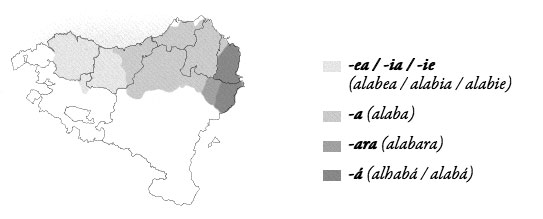
- 2. The 2nd person plural forms of intransitive verbs bear the suffix -te in most areas: zarete ‘you-pl are’, zineten ‘you-pl were’, zabiltzate ‘you-pl walk’, zaudete ‘you-pl are, stay’, etc. The geographical domain of this innovation is more or less the same as that of the previous innovation. That is, it is not found in Zuberoa, Erronkari, Zaraitzu, Sakana or the Western dialect area. In these areas, the plural morpheme is -(i)e instead: zarie ‘you-pl are’ (instead of zarete), ziñen/ziñien ‘you-pl were’ (zineten), etc.
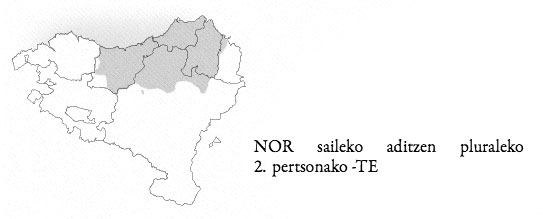
- 3. In the verbal noun and imperfective participle, the morpheme -tzen has been extended to most verbs: ibiltzen ‘walking’, jartzen ‘putting’. In both lateral areas, we find a greater use of -ten instead: ibilten/ebilten, jarten.
VITORIA/GASTEIZ
The plains of Araba could have been the focal point for most innovations now found throughout the Western dialect area. In the 11th century, when the bishopric of Armentia was established, Vitoria/Gasteiz had a large urban core. The innovations that emerged in and around Gasteiz spread througout a large area: Bizkaia, the valleys of Goierri, Urola, and Deba in Gipuzkoa, the regions of Burunda, Ameskoa, and Lana in Navarre, and parts of the present-day provinces of Burgos and La Rioja, where Basque was spoken at the time. All of the following could be innovations that spread from Gasteiz:
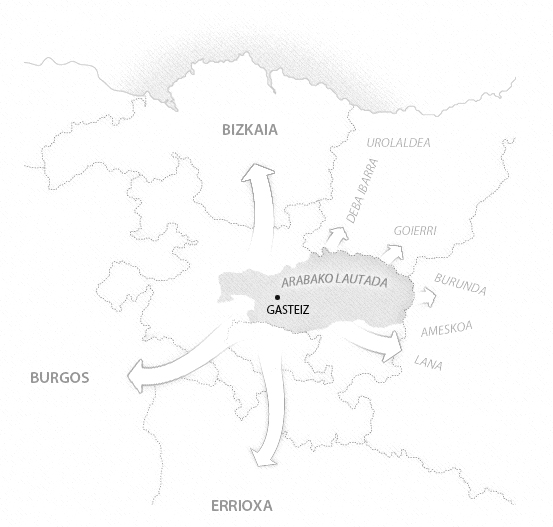
- 1. When words ending in -a are combined with the definite article, we find the evolution -a + a > -ea: luma + a > lumea ‘the feather’.
- 2. A preceding palatal semivowel palatalizes z and tz and turns into them x/tx: haize > axe ‘wind’, haitz > atx ‘rock’.
- 3. The use of the comitative suffix -gaz: lagunagaz ‘with the friend’ (instead of lagunarekin).
- 4. The use of the directional allative morpheme -rutz: barrurutz ‘inwards’.
- 5. The use of the inessive case instead of the allative with verb nouns that function as complements of verbs of movement: laguna ikusten noa ‘I am going to see my friend’ (vs. laguna ikustera noa in other dialects).
- 6. The use of the suffix -rik in idiomatic expressions like etxerik etxe ‘from house to house’, kalerik kale ‘through the streets’.
- 7. The full development of the “edo ‘or’ + interrogative pronoun” set of pronouns: edonor ‘whoever’, edonon ‘wherever’, edonora ‘(to) wherever’, edonondik ‘from wherever’, etc.
- 8. The use of the suffix -to in adverbials: ederto ‘beautifully’ (vs ederki), polito ‘slowly’ (vs poliki).
- 9. The addition of a final -n to the adverbial suffix -la: nolan ‘how’, honelan ‘thus, like this’, halan ‘like that’.
- 10. The use of egin as an auxiliary in non-indicative moods: jan egizu ‘eat!’ ( vs jan ezazu in other dialects).
- 11. The use of eutsi as a trivalent auxiliary: deust ‘s/he has it to me’ (standard dit).
- 12. The prefix j- in bivalent intransitive forms: jako ‘it is to him/her’ (standard zaio), jatort ‘it comes to me’ (standard datorkit).
- 13. The generalization of the pluralizar -z in verbal forms: jakuz ‘they are to us’ (standard zaizkigu).
- 14. The adaptation of verbs borrowed from Spanish as -ado > -adu and -ido > -idu: konfiadu ‘to trust’ (standard konfiatu), atrebidu ‘to dare’ (standard atrebitu).
- 15. The use of several distinct endings in the imperfective participle: a) -etan: suplikaetan ‘begging’ (standard suplikatzen), b) -ketan: bidalketan ‘sending’ (bidaltzen), c) -zaiten/-zaen: heltzaiten/heltzaen (heltzen).
- 16. The use of -tearren in causative and purpose clauses: zu ikustearren etorri da ‘s/he has came to see you’ (zu ikusteagatik etorri da).
THE CENTER OF BIZKAIA
Even though initially the axis of the Western dialect was Araba, by the 16th Bizkaia was no longer under its orbit and new innovations developed in Bizkaia itself. It seems that at this time the center of Bizkaia was the epicenter of innovations; in particular the axis formed by Durango-Zornotza-Gernika-Bermeo. The development of Bilbao as an important city took place later, at a time when the dialect was already structured. These are the most relevant Bizkain innovations:
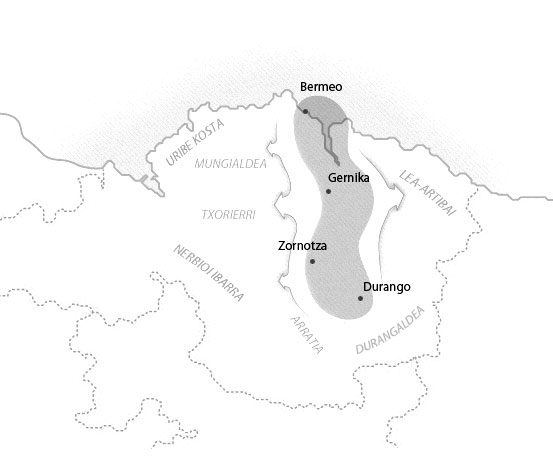
- 1. The development of the palatal nasal -ñ- after the nasalized vowel i. This can be seen mainly in the verb *io and the ending -(z)io < Sp -ción. On the one hand, we find the verb forms diño ‘s/he says’ (standard dio), diñozu ‘you say (diozu), etc., and on the other hand, words like konfirmaziño ‘confirmation’ (standard konfirmazio), konsagraziño ‘consecration’ (kontsakrazio), etc.
- 2. The use of the diminutive suffix -txu: axetxu ‘little wind’ (haizetxo).
- 3. The use of -tuten in imperfective participles: aginduten ‘ordering’ (standard agintzen), elduten ‘arriving’ (heltzen), etc.
- 4. The placement of the demonstrative before the noun: onek gauzok ‘these things’ (gauza hauek).
Some other changes look more recent, maybe from the beginning of the 19th century:
- 1. The tendency to convert -au into -eu: aurre > eurre ‘front’, gaur > geur ‘today’. Also, a related change is the reduction au > e in conjugated forms of eduki ‘to have’ : daukat > dekot ‘I have it’, dauka > deko ‘s/he has it’.
- 2. The palatalization of sibilants after the vowel i: izan > ixen ‘to be’, izar > ixer ‘star’, gizon > gixon ‘man’, dakizu > dakixu ‘you know’, etc.
- 3. Indefinite pronouns with the morphological structure “interrogative pronoun + edo + interrogative pronoun”: nor edo nor (> nonor) ‘someone’, nor edo nogaz (> nonogaz) ‘with someone’, non edo non (> nonon) ‘somewhere’, nora edo nora (> nonora) ‘to somewhere’.
THE EAST
The eastern part of the Basque Country has been an area prone to innovation. The exact place of origin of these innovations is not very clear, but some of the oldest ones may have originated in formerly-Basque speaking areas of Béarn or Huesca. These are the most relevant eastern innovations:
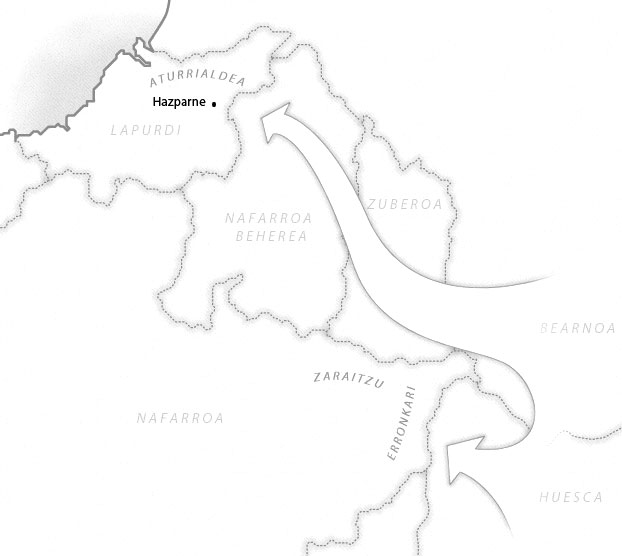
- 1. The development /u + a, e/ > i: eskua > eskia ‘the hand’, duela > diela ‘that s/he has it’.
- 2. The contractions -ai- > -i- and -au- > -u- in verb forms. Thus, on the one hand, we find naiz > niz ‘I am’, gaitu > gitu ‘s/he has us’, gaitzake > gitzake ‘s/he can have us’, and, on the other, nauk > nuk ‘you fam. masc. have me’, nauzu > nuzu ‘you have me’.
- 3. The dative plural suffix -er: laguner ‘to the friends’ (standard lagunei).
- 4. The comitative suffix -kila(n): lagunekilan ‘with the friends’ (standard lagunekin).
- 5. The use of the zuketa and xuketa allocutive conjugations: mintzatu behar dizit/dixit ‘I have to talk’ (mintzatu behar dut).
- 6. The interrogative suffix -a: jin dea? ‘has s/he arrived?’
The following innovations are used in a more limited area. They are found in Zuberoa and adjacent regions:
- 1. When words ending in -a take the definite article the vowel sequence is contracted and the stress is shifted to the last syllable of the word, -a + a > -á: lüma + a > lümá ‘the feather’.
- 2. The complete long-distance assimilation of u - i > u - u > ü - ü and i - u > u - u > ü - ü: burdina > bürdüña ‘iron’, ilhun > ülhün ‘dark’.
- 3. -au- > -ai-: gau > gai ‘night’, gauza > gaiza ‘thing’.
- 4. The use of the article with the allative: mendialat ‘to the mountain’ (standard mendira).
- 5. The diminutive suffix -ñi: amiñí ‘a little bit’.
BETERRI
A number of urban areas developed in Gipuzkoa along the road from Pamplona/Iruñea to the coast: Tolosa, Andoain, Hernani and Donostia/San Sebastian. It appears that this axis has also been the source of some innovations, which spread to the surrounding area. Here are the most important among them:
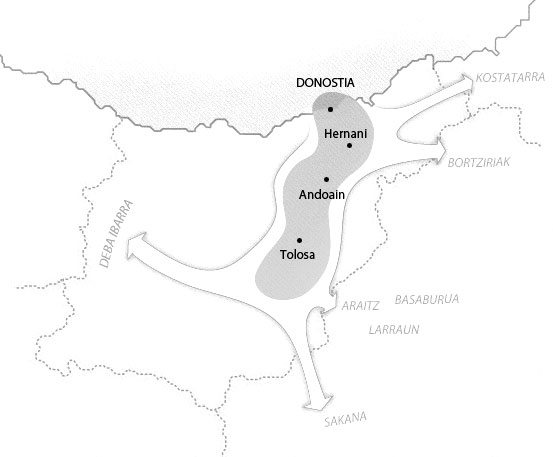
- 1. The use of the vowel -e- in the root of the present tense verb forms of *edun: det ‘I have’ (standard dut).
- 2. The use of the vowel -e- in the root of several present tense verb forms of izan: gera ‘we are’ (standard gara).
- 3. The use of distinctive verb forms for the verb joan: nijoa ‘I go’ (standard noa), dijoa ‘s/he goes’ (standard doa).
- 4. The use of the pluralized -zki- in allocutive transitive forms: dizkiat/dizkinat ‘I have them’ (standard ditiat/ditinat).
THE TRIPLE DIVISION OF BASQUE
By the 16th century, when the first long texts in Basque that have arrived to us were written, the language was already diversified in dialects. We can, furthermore, identify two important linguistic boundaries within the Basque-speaking territory at the time. On the one hand, the provinces of Araba, Bizkaia and Gipuzkoa were already separated from Navarre and the Northern Basque Country. On the other hand, the Northern Basque Country and the Southern Basque Country appear to be separated from each other. In other words, there are three main zones: a) Araba, Bizkaia and Gipuzkoa, b) Navarre, and c) the Northern Basque Country. Of course, the limits of these areas do not completely match the administrative borders. Regarding many linguistic phenomena, the valleys of northern Navarre seem to have been more closely linked to the Northern Basque Country than to the rest of Navarre; whereas the western Navarrese valleys show affinities with Gipuzkoa and/or Araba. The speech of the southwestern part of Lapurdi also shows the effects of its proximity to Gipuzkoa.
The reasons for this division into three main dialectal areas are not completely certain, but it could be related to the breaking up of the Kingdom of Navarre. If this hypothesis is correct, the political division of the Basque Country would have triggered an increase in dialectal differences. But, regardless of whether this hypothesis is true or not, the language itself does show this triple division. Let us, then, analyze these three main zones individually.
THE WESTERN AND THE CENTRAL AREAS VS THE NORTHERN BASQUE COUNTRY AND NAVARRESE BASQUE
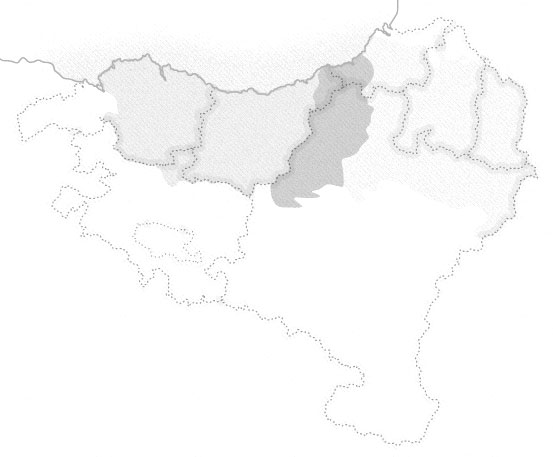
Seven significant features can be mentioned in this respect:
- 1. In the west and center of the Basque Country, the consonant cluster -st- is used in a number of words where -rtz- is found in most of the eastern area: beste/bertze ‘other’, bost/bortz ‘five’, heste/hertze ‘intestine’, ostegun/ortzegun ‘Thursday’. It is important to note, however, that -st- is used in Zuberoa and the surrounding areas as well, in the easternmost corner of the Basque-speaking territory.
- 2. Whereas in the west and center, -gan is used in the animate inessive, in the east baitan is employed in this case instead: lagunarengan / lagunaren baitan ‘in the friend’.
- 3. In the west and center, -a- is used in the third person singular of the verb izan ‘to be’ when it bears a complementizer, whereas in the east the vowels is -e-: dan/den ‘which is’, dala/dela ‘that it is’, dalako/delako ‘because it is’, zan/zen ‘which was’, zala/zela ‘that it was’, and zalako/zelako ‘because it was’.
- 4. The future tense suffix is -go in the west and center, and -en in the east: egingo/eginen ‘will do’.
- 5. In the west and center, the direct object of uninflected clauses is expressed in the absolutive case; whereas in the east, the genitive is used: laguna ikustera joan/lagunaren ikustera joan ‘to go see the friend’.
- 6. The nonfinite complement of certain verbs takes inessive marking in the west and center, but allative marking in the east. Here are some eastern examples from B. Etxepare (1545):
- assayatu bere lengoage propriaren favoretan heuscaraz cerbait obra eguitera (foreword: 9-10)
‘...try to do some work in favor of his own Basque language’
- finian ere eztic uzten harc galcera beria (II: 72)
‘even at the end he does not let you lose his own’
neure penen erraytera are eniz ausarcen (V: 12)
‘I do not dare tell my own sorrows’
- 7. In the west and center, -ela is used in temporal and modal clauses, while -elarik is used in the east. Joanes Leizarraga, who was from Lapurdi, wrote the following in 1571:
- ni çure eçagun gabea beçala naicelaric (…) ‘As I am like someone unknown to you’
- orain çure moienez reedificatzen delaric (…)‘As it is being rebuilt now through your means’
In these examples Etxepare wrote asaiatu egitera ‘try to do’, utzi galtzera ‘let lose’ and ausartu erraitera ‘dare say’, following the eastern syntactic rule. In the west and center, these would have been saiatu egiten, utzi galtzen, and ausartu esaten.
THE NORTHERN BASQUE COUNTRY VS THE SOUTHERN BASQUE COUNTRY
Six characteristics can be mentioned in this respect:
- 1. Aspiration was lost in the Southern Basque Country by the 16th century. The speech of some northern Navarrese regions like Luzaide was the only exception.
- 2. Before nasal consonants, there is a tendency to turn o into u in the Northern Basque Country. In Etxepare’s text, for example, we find huin ‘foot’ (standard oin), hun ‘good’ (on), unsa ‘well’ (ongi, ondo), undar ‘sand, remainder’ (hondar) and demonstratives like hunek ‘this, ergative’ (honek) and related forms (hunen ‘of this’, huneki ‘with this’, hunat ‘hither’).
- 3. When adapting Romance loanwords, the language of each side of the border acted differently. In the Northern Basque Country, in contact with Gallo-Romance varieties that had lost many final vowels, -a was often added to Romance consonant-final nouns and adjectives. Etxepare, for example, used adbokata ‘lawyer’, demandanta ‘plaintiff’, desonesta ‘dishonest’, elementa ‘element’, and pazienza ‘pacience’. In the Southern Basque Country, instead, these would have been abogadu, demandante, desonesto, elemento and pazienzia.
- 4. In the Northern Basque Country, -rat is used in the allative; whereas the form -ra is used in the Southern Basque Country. Etxepare, for example, wrote hunat ‘hither’, horrat ‘there, thither’, harat ‘over there, thither’, norat ‘whither’ and aitzinerat ‘foreward’.
- 5. The strengthened pronouns of the Northern Basque Country are very distinctive: Etxepare used nihaur ‘I myself’, ihaurk/ihaurorrek ‘you yourself, fam.’, guhaur ‘we ourselves’, and zuhaurk/zuhaurorrek ‘you yourself’.
- 6. In the Northern Basque Country, relative clauses are constructed with the participle, and Etxepare provides some examples of this as well (I: 436):
- eguin oroz recebitu neure merexituya‘receive my compensation for everything (I have) done’
In the Southern Basque Country this would be expressed ay one of the following alternative expressions : egin ditudan / egindako / eginiko / eginikako.
Bibliography
BARRENA, Elena
- 1989. La formación histórica de Guipúzcoa. Donostia: Cuadernos Universitarios. Sección Historia, 5. E.U.T.G.- Mundaiz.
CARO BAROJA, Julio
- 1943. Los pueblos del norte de la Península Ibérica. Madrid: Consejo Superior de Investigaciones Científicas.
- 1945. Materiales para una historia de la lengua vasca en su relación con la latina. Salamanca: Universidad de Salamanca.
ETXEPARE, Bernat
- 1545. Linguae Vasconum Primitiae. [P. Altuna, ed.] Bilbo: Mensajero, 1980.
HUALDE, Jose Ignacio
- 1997. Euskararen azentuak. Supplements of ASJU-42. Donostia and Bilbo: Gipuzkoako Foru Aldundia and Euskal Herriko Unibertsitatea.
LARRAMENDI, Manuel
- 1745. Diccionario trilingüe del castellano, bascuence y latín (2 issues). Donostia: Bartolomé Riesgo Montero.
LEIZARRAGA, Joanes
- 1571. Jesus Christ gure Jaunaren Testamendu Berria. Arroxela: Pierre Hautin. Faksimile: Donostia, Hordago, 1979.
MITXELENA, Koldo
- 1981. "Lengua común y dialectos vascos". Anuario del Seminario de Filología Vasca "Julio de Urquijo", 15: 289-313. Donostia: Gipuzkoako Foru Aldundia.
OIHENART, Arnaut
- 1656. Notitia utriusque Vasconiae tum Ibericae tum aquitanicae. Second revised edition [J. Gorosterratzu, transl.] Revista Internacional de Estudios Vascos, 17-19 (1926-1928). Faksimile Gasteiz: Eusko Legebiltzarra, 1992.
URGELL, Blanca
- 2006. "Para la historia del sustantivo verbal en vasco". Anuario del Seminario de Filología Vasca "Julio de Urquijo", 40/1-2: 921-948. Donostia and Bilbo: Gipuzkoako Foru Aldundia and Euskal Herriko Unibertsitatea.
ZUAZO, Koldo
- 2010. El euskera y sus dialectos. Irun: Alberdania.
- 2014. Euskalkiak. Donostia: Elkar.
- 2019. Standard Basque and its Dialects. London and New York: Routledge.





